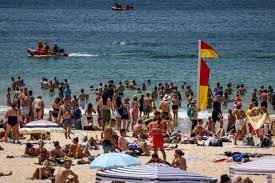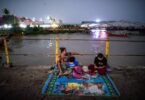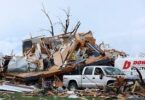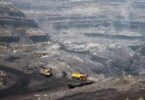SYDNEY (AFP): A heatwave scorched Australia’s eastern coast and sent temperatures in Sydney to a three-year high Saturday as firefighters battled runaway bushfires.
Many people crowded Sydney’s beaches or sought relief in the shade. Authorities warned the most vulnerable, including the elderly and very young, to shelter in cool buildings.
Sydney city centre’s Observatory Hill weather station reached 40 degrees Celsius (104 degrees Fahrenheit) in the afternoon — the hottest since November 2020, according to weather bureau data.
In Richmond on Sydney’s far western fringes, the thermometer crept up to 43.8C (110.8F).
“Today, with the high heat levels, I do say that it’s a time to ensure that we look after each other and stay safe,” Prime Minister Anthony Albanese told a news conference.
“Climate change is a threat to people’s health as well as to our environment and we need to acknowledge there’s a need for a comprehensive response.”
More than 70 bushfires and grass fires burned across New South Wales, with over a dozen out of control in the late afternoon, the state’s rural fire service said.
“With very hot, dry and windy conditions, and total fire bans in place, know your risk and what you will do if threatened by fire,” the fire service said in a message on social media.
Temperatures were set to cool in the evening, the Bureau of Meteorology said.
It urged vulnerable people to use fans and air conditioners or seek cool spots in libraries, community centres and shopping centres.
– ‘Take breaks from dancing’ –
The number of calls for ambulances rose by about 20 percent compared to a normal day, New South Wales Ambulance chief superintendent Mark Gibbs told a news conference.
“Follow up on elderly relatives. Check in on your neighbours. Ensure that people are rehydrating,” Gibbs said.
“Monitor people for signs of dehydration or effects from the heat — and that may be a decreased level of consciousness, vomiting, lethargy, feeling fatigued, potentially muscle twitching.”
State health authorities called on people attending music festivals to protect themselves, with thousands expected at an event in western Sydney’s Olympic Park.
“Make sure you take breaks from dancing, seek shade when you can, drink water regularly, wear sun protection,” NSW Health said in a statement.
“Make use of festival-provided shade, water stations and misting fans.”
After several wet years, experts are expecting Australia’s summer to bring the most intense bushfire season since the 2019-2020 disaster.
During that “Black Summer”, bushfires raged across Australia’s eastern seaboard, razing swathes of forest, killing millions of animals and blanketing cities in noxious smoke.
Australia’s weather bureau confirmed in September that an El Nino weather pattern is underway, bringing hotter and drier conditions to the country.
Australia is one of the world’s largest producers and exporters of gas and coal, two key fossil fuels that are blamed for global heating.
Under Albanese’s centre-left government, the country has vowed to cut carbon emissions by 43 percent before 2030 when compared to 2005 levels.







